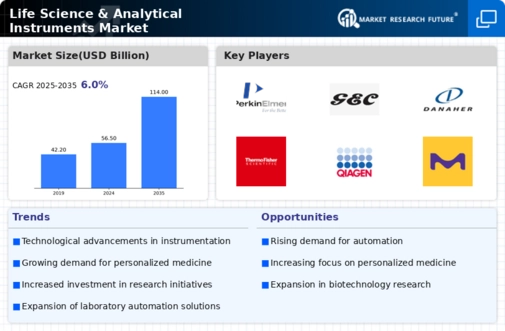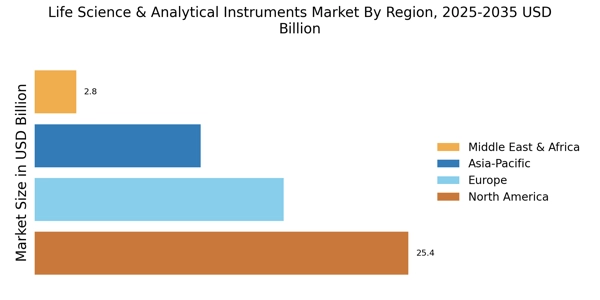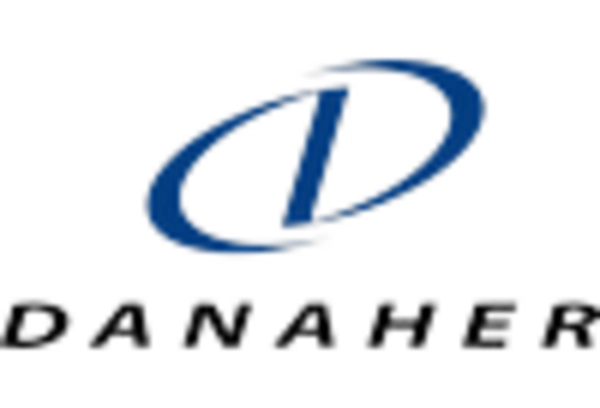Rising Demand for Advanced Diagnostics
The Life Science & Analytical Instruments Market is experiencing a notable surge in demand for advanced diagnostic tools. This trend is largely driven by the increasing prevalence of chronic diseases and the need for early detection methods. According to recent data, the market for diagnostic instruments is projected to grow at a compound annual growth rate (CAGR) of approximately 7% over the next five years. This growth is indicative of a broader shift towards precision medicine, where accurate diagnostics play a crucial role in treatment decisions. As healthcare providers seek to enhance patient outcomes, the integration of sophisticated analytical instruments becomes essential. Consequently, manufacturers are focusing on innovation to meet these evolving needs, thereby propelling the Life Science & Analytical Instruments Market forward.
Emergence of Automation and Digitalization
The emergence of automation and digitalization is reshaping the landscape of the Life Science & Analytical Instruments Market. As laboratories seek to enhance efficiency and reduce human error, the integration of automated systems and digital tools is becoming increasingly prevalent. This shift is supported by advancements in artificial intelligence and machine learning, which enable more precise data analysis and interpretation. The market for automated analytical instruments is projected to grow significantly, with estimates indicating a CAGR of approximately 8% over the next few years. This trend not only streamlines laboratory workflows but also allows for real-time monitoring and data management, thereby improving overall productivity. As the demand for high-throughput screening and data-driven decision-making rises, the Life Science & Analytical Instruments Market is poised for substantial growth.
Increased Investment in Biopharmaceuticals
The Life Science & Analytical Instruments Market is witnessing a significant boost due to increased investment in biopharmaceuticals. As the biopharmaceutical sector expands, driven by the need for novel therapies and biologics, the demand for analytical instruments that can support complex manufacturing processes is on the rise. Recent estimates suggest that the biopharmaceutical market could reach a valuation of over $500 billion by 2026, necessitating advanced analytical solutions for quality assurance and process optimization. This trend is prompting manufacturers to innovate and develop instruments that cater specifically to the unique requirements of biopharmaceutical production. As a result, the Life Science & Analytical Instruments Market is likely to benefit from this influx of investment, leading to enhanced technological advancements and market growth.
Growing Focus on Quality Control and Assurance
Quality control and assurance are becoming increasingly critical in the Life Science & Analytical Instruments Market. As regulatory bodies impose stricter guidelines on product quality, manufacturers are compelled to adopt advanced analytical instruments to ensure compliance. The market for quality control instruments is expected to grow steadily, with a projected CAGR of around 6% in the coming years. This growth is driven by the need for accurate testing and validation processes in industries such as pharmaceuticals, food and beverage, and environmental monitoring. The emphasis on maintaining high standards not only safeguards consumer health but also enhances the reputation of companies within the Life Science & Analytical Instruments Market. Consequently, the demand for reliable and efficient analytical tools is likely to rise, further propelling market growth.
Expansion of Research and Development Activities
The Life Science & Analytical Instruments Market is significantly influenced by the expansion of research and development (R&D) activities across various sectors. Increased funding from both public and private entities has led to a robust environment for scientific exploration. For instance, investments in biotechnology and pharmaceuticals have surged, with R&D expenditures reaching unprecedented levels. This influx of capital is fostering innovation in analytical instruments, which are vital for conducting experiments and validating results. As researchers demand more sophisticated tools to analyze complex biological systems, the market is likely to witness a corresponding increase in the adoption of advanced analytical technologies. This trend not only enhances the capabilities of laboratories but also drives the overall growth of the Life Science & Analytical Instruments Market.


















Leave a Comment